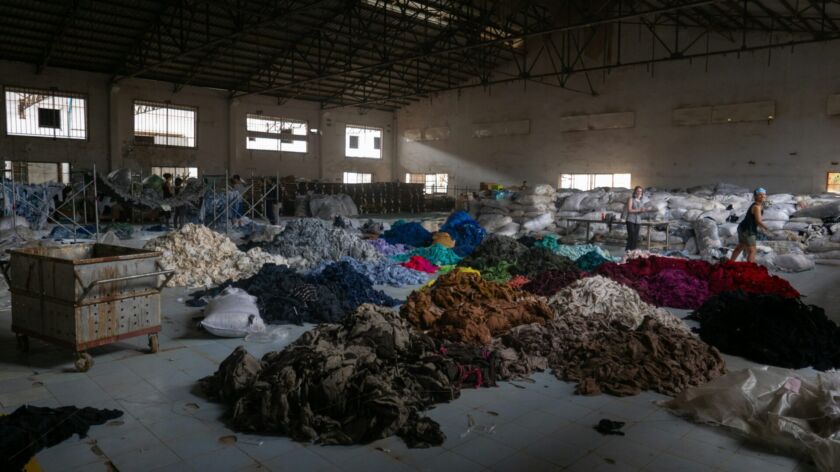How students and scientists are navigating the fast fashion dilemma
-
 Foto ter illustratie. Via unsplash
Foto ter illustratie. Via unsplash
In a world where a ready meal can cost more than a brand-new outfit, it’s easy to see how the appeal of affordability can cloud our eco-consciousness. But what is the science behind fast fashion? And how do Radboud students engage with it?
At Radboud University, questions surrounding environmental impact are seemingly everywhere. Whether through initiatives of the Radboud Green Office, nation-wide campaigns against environmental destruction, or campus restaurants going vegan – how to think (and act) green is definitely in fashion. And one of the most pressing questions when it comes to environmental dilemmas is about precisely that: the fashion industry – and the cycles of consumerism that come with that.
‘Avoid fast fashion because it’s bad for the planet’ is a familiar refrain to many. It’s echoing the detrimental impact of fast fashion, where trends quickly turn from fashion to ‘trashion’ – piling up in landfills. Yet, in the heat of the moment, when that H&M or Zara dress you’ve been eyeing up for your summer holiday drops under five euros, are you torn between conscience and the allure of a cheap tag?
In-fashion
Anneke Smelik has spent her research career researching focusing on exactly that: fashion’s impact on the environment. The professor emeritus knows all about the euphoria that comes with snagging budget-friendly fits that instantly boost confidence. And Smelik knows that approaching the topic is not always straight-forward.
For Smelik, fashion isn’t just about fashion: ‘An important breakthrough in understanding fashion for me was the intrinsic link between fashion and identity. We want to look good, so we keep consuming,’ the researcher explains. For example, by giving in to the temptation to buy a new outfit for every new occasion.
Consequently, consumers adopt unsustainable consumption habits when striving to remain ‘in-fashion’. Including a growing preference for purchasing the cheapest items possible, as they’re viewed as disposable after just one or two wears. A practise that includes shopping at second-hand stores just as much as fast-fashion brands like Shein, Bershka, and Mango.
‘Someone, somewhere always pays the price’
The buy, wear, throw cycle of consumption directly contradicts the sustainable practise of reusing clothes for extended periods. For Smelik, fast fashion is an inherently unsustainable field: ‘Someone, somewhere always pays the price,’ she says. ‘Because of that, sustainability is not only ecological but also social. Fast fashion harms both the environment and employees with low wages and poor working conditions. This leads to exploited labour and reduced profits for manufacturers. It’s a cycle where affordability for some comes at the expense of others.’
Bad materials
In the past, Smelik has researched New Materialism, a field that seeks to understand the material production processes within the fashion industry. That includes a comparison between polyester and cotton: the ‘villain’ versus the ‘hero’. ‘Polyester poses environmental challenges due to its non-biodegradable plastic composition and the carbon emissions released during production,’ Smelik explains.
But that doesn’t mean that a supposedly more environmentally friendly material like cotton is actually good for the environment. ‘Cotton is much more ambiguous and complicated. It is not as simple as categorising one material as unsustainable and the other as not.’ Cotton uses excessive water during production, for example, so according to Smelik, polyester is actually preferable.
Top-down
So, if research is ‘counter-intuitive’, then how do we enact clear-cut solutions to produce tangible change? While it is tempting to point fingers and search for a single bad guy, Smelik says that we must all work together to change the world to become more sustainable. ‘Most importantly, there is a multi-layered top-down approach,’ she explains. ‘Responsibility lies not only with the consumer but also with the big player brands and institutions. Through this collaborative attitude, we can initiate change towards a greener future.’
Ways of doing that, Smelik says, are for example clothes swaps, raising awareness through social media or lecturers, and advocating for political initiatives such as the European Green Deal: ‘It’s great that the EU is making progress by establishing sustainability standards for textiles. Any materials failing to meet these conditions are barred from import.’
‘Responsibility lies not only with the consumer but also with the big player brands and institutions’
According to Smelik, there’s a real opportunity here for sustainability to become more than just a passing trend – it could become ingrained in our consumer behaviour and even become a core value of big brands. ‘Embracing sustainability offers a more meaningful and lasting focus than short-lived fashion trends like poorly executed tie-dye designs,’ Smelik says.
But what do Radboud students, after all major target groups for the fast fashion industry, think about sustainable fashion practices?
Lucia De Fez (20) from Spain.

‘I came across a The New York Times article on overconsumption with a heart-breaking photo of overflowing clothing bins. It made me realise how unsustainable our consumption habits are. As a budget-conscious student, I’m sometimes tempted by cheap clothes, despite their quality. But I’ve realised this pattern needs to change. We can’t support fast fashion without considering the consequences.’
Martina Jude Engel (19) from Uruguay

‘I support brands with ethical practices and believe in making clothes last longer. I enjoy upcycling my clothes when I get bored. While I promote thrifting for sustainability, I’m cautious of excessive online shopping. Physical second-hand stores like Het Goed are my go-to to minimise my carbon footprint!’
Ben Galloway (20) from Scotland

‘My perspective shifted when my sister introduced me to unique second-hand pieces from Japan. During the pandemic, while reflecting on my wardrobe, I noticed a surge in online shopping platforms like Vinted and Depop. I realised second-hand clothes aren’t ‘gross’ – a hot wash can solve that misconception! Dressing to one’s own taste, rather than following trends is empowering and leads to unique finds.’




